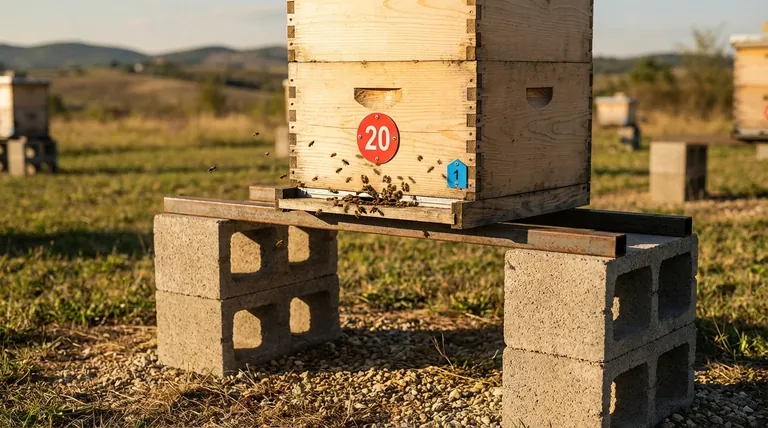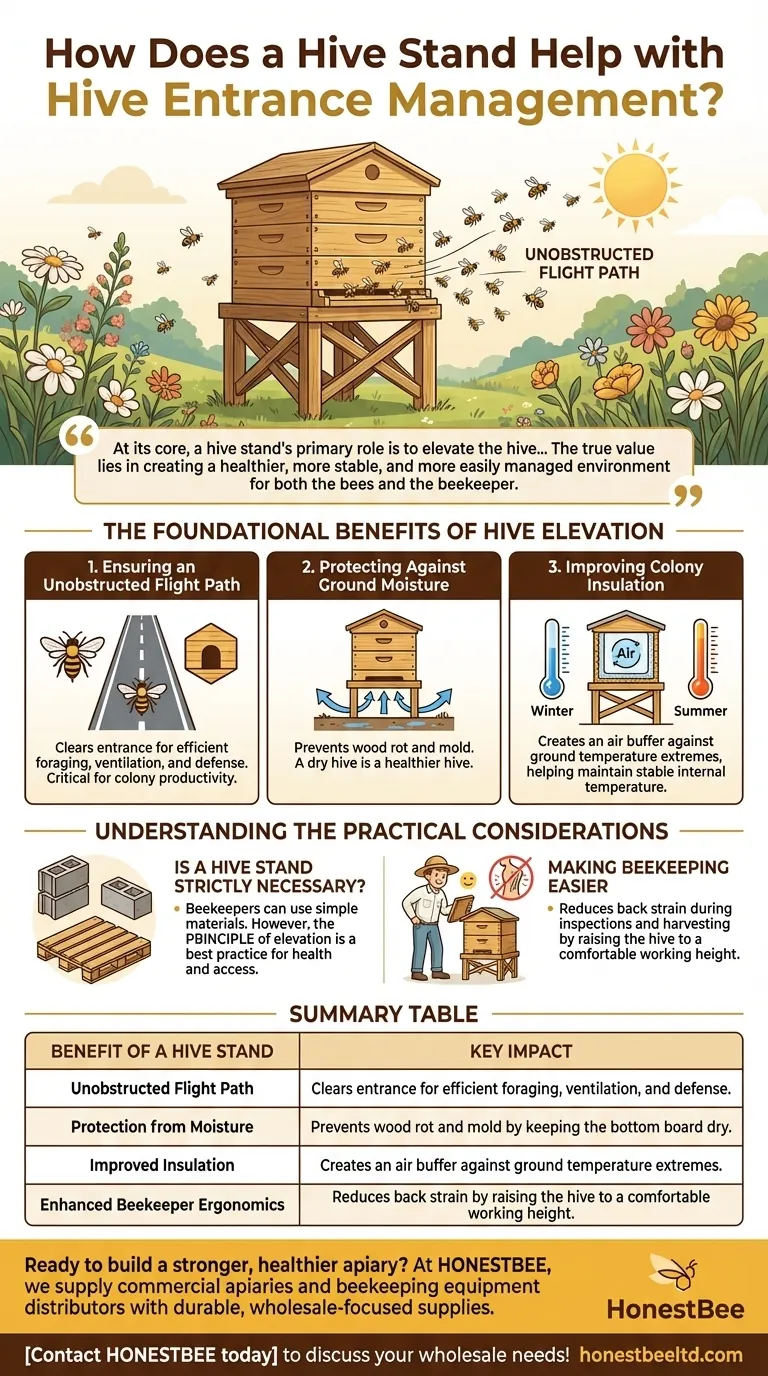At its core, a hive stand's primary role in entrance management is to elevate the hive, which prevents grass, weeds, and other vegetation from blocking the bees' flight path. This simple elevation ensures the colony has an unobstructed entrance for foraging, ventilation, and defense.
While clearing the entrance is the most direct benefit, the true value of a hive stand lies in creating a healthier, more stable, and more easily managed environment for both the bees and the beekeeper.

The Foundational Benefits of Hive Elevation
Elevating a beehive is a fundamental practice that solves multiple problems simultaneously. It addresses issues ranging from hive access and moisture control to beekeeper ergonomics.
Ensuring an Unobstructed Flight Path
The most immediate impact of a hive stand is on the entrance. A clear entrance allows for an efficient "bee highway," letting foragers come and go without obstruction.
This unobstructed access is critical for the colony's productivity and ability to regulate its internal environment.
Protecting Against Ground Moisture
Placing a hive directly on the ground exposes the bottom board to constant moisture. This dampness can lead to wood rot, mold growth, and a chilled environment inside the hive.
By elevating the hive, a stand allows air to circulate underneath, keeping the bottom board dry and significantly extending the life of your equipment. A dry hive is a healthier hive.
Improving Colony Insulation
A hive stand creates a crucial pocket of air between the hive and the ground. This air gap acts as a buffer against temperature extremes.
In the winter, it insulates the colony from the cold, frozen ground, and in the summer, it protects them from excessive heat radiating upwards. This helps the bees maintain a stable internal temperature with less effort.
Understanding the Practical Considerations
While highly recommended, it's important to understand that a hive stand is a tool to achieve a goal—elevation—not a mandatory piece of equipment in all circumstances.
Is a Hive Stand Strictly Necessary?
Beekeepers have successfully kept bees without dedicated stands, often using simple materials like cinder blocks or wooden pallets. The stand itself is not magic.
However, the principle of elevating the hive is considered a best practice. Failing to do so invites problems with moisture, pests, and hive access that are easily avoided.
Making Beekeeping Easier
Beyond benefits for the bees, a hive stand makes the beekeeper's job significantly easier and more comfortable.
Lifting a hive to a comfortable working height (knee or waist level) reduces back strain during inspections, hive manipulations, and honey harvesting.
Making the Right Choice for Your Goal
Your decision on how to elevate your hive should be based on your specific priorities for your apiary.
- If your primary focus is hive health: Elevating the hive to prevent moisture and ensure a clear entrance is one of the most effective actions you can take.
- If your primary focus is budget: Simple, sturdy materials like two or four cinder blocks provide the necessary elevation and stability at a minimal cost.
- If your primary focus is beekeeper comfort: A dedicated stand that raises the hive to waist height is a worthwhile investment to prevent long-term back strain.
Ultimately, elevating your hive is a foundational step in proactive, responsible, and sustainable beekeeping.
Summary Table:
| Benefit of a Hive Stand | Key Impact |
|---|---|
| Unobstructed Flight Path | Clears entrance for efficient foraging, ventilation, and defense. |
| Protection from Moisture | Prevents wood rot and mold by keeping the bottom board dry. |
| Improved Insulation | Creates an air buffer against ground temperature extremes. |
| Enhanced Beekeeper Ergonomics | Reduces back strain by raising the hive to a comfortable working height. |
Ready to build a stronger, healthier apiary?
A properly elevated hive is the foundation of successful beekeeping. At HONESTBEE, we supply commercial apiaries and beekeeping equipment distributors with the durable, wholesale-focused supplies needed to support thriving colonies.
Let us help you equip your operation for maximum productivity and bee health.
Contact HONESTBEE today to discuss your wholesale needs!
Visual Guide

Related Products
- Professional Engraved Round Hive Number Tags for Beekeeping
- Plastic Bee Hive Stand for Beekeeping
- Professional Ant-Proof Beehive Stand with Integrated Moat for Beekeeping
- Wholesales Dadant Size Wooden Bee Hives for Beekeeping
- Professional Galvanized Hive Strap with Secure Locking Buckle for Beekeeping
People Also Ask
- How can hive stands be made more secure in windy areas? Anchor Your Apiary Against the Elements
- Why should beekeepers consider using hive stands? Protect Your Hives and Your Back
- What maintenance is required for hive straps? A Guide to Cam Buckle vs. Ratchet Strap Care
- Do I need a hive stand? Essential for Bee Health & Easier Beekeeping
- What is the purpose of a hive stand, and why is it beneficial? Elevate Your Hive for Colony Health and Beekeeper Comfort



















